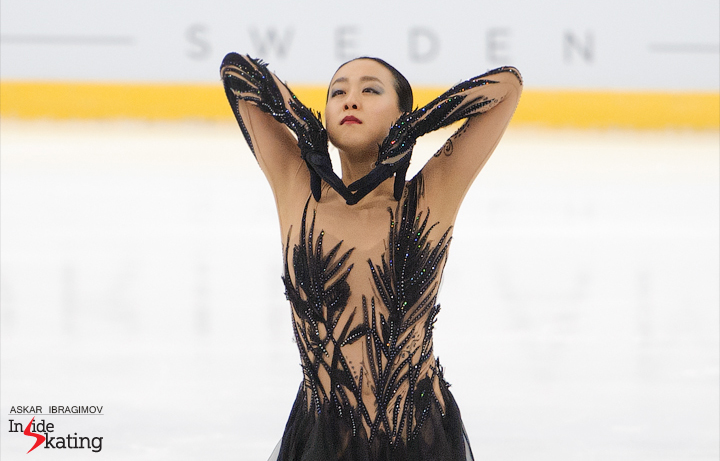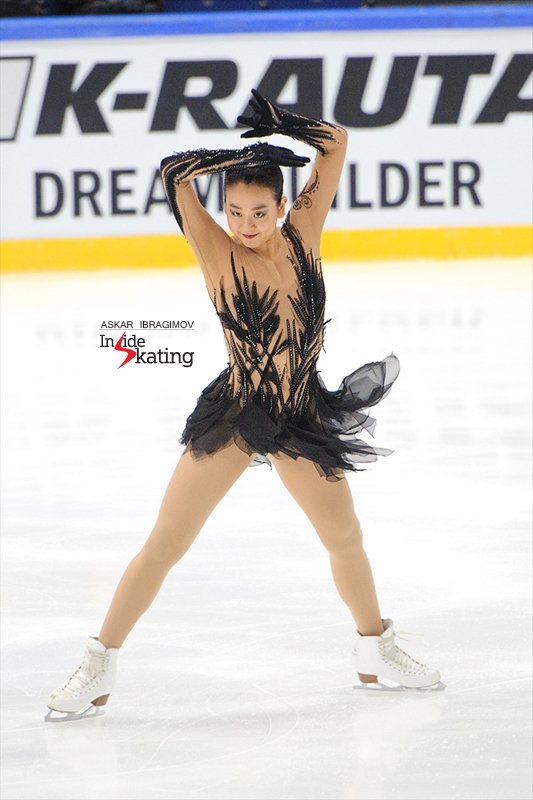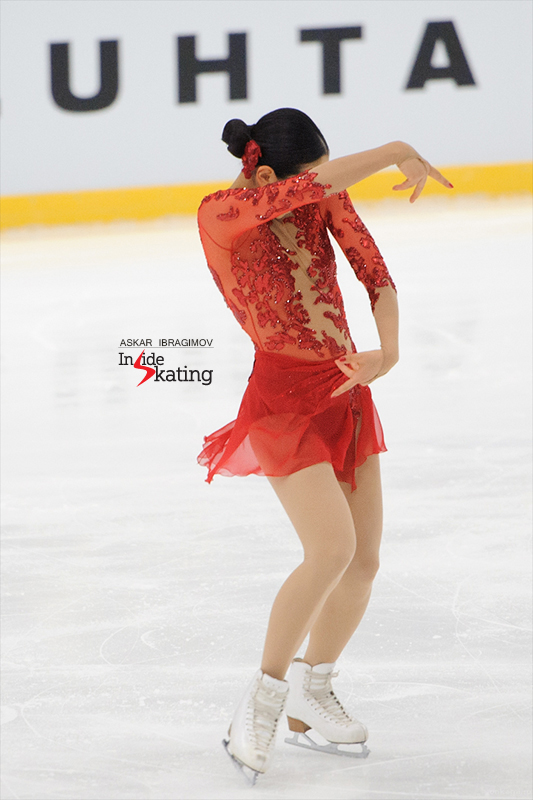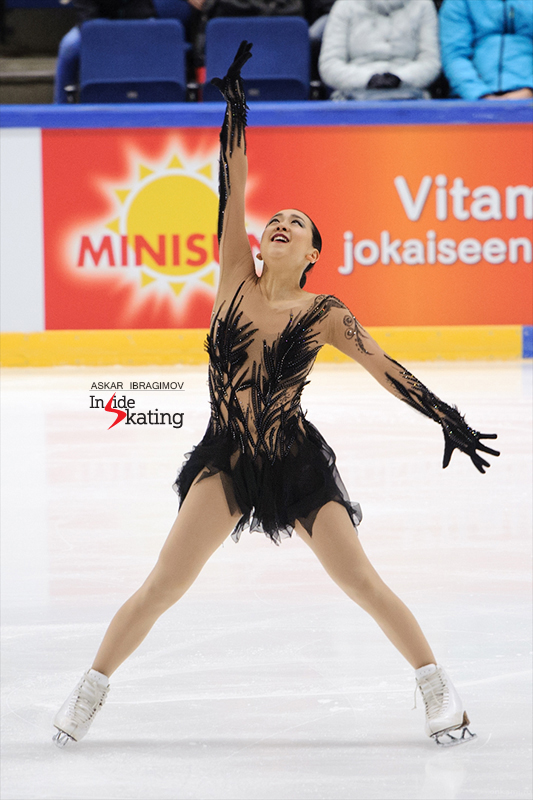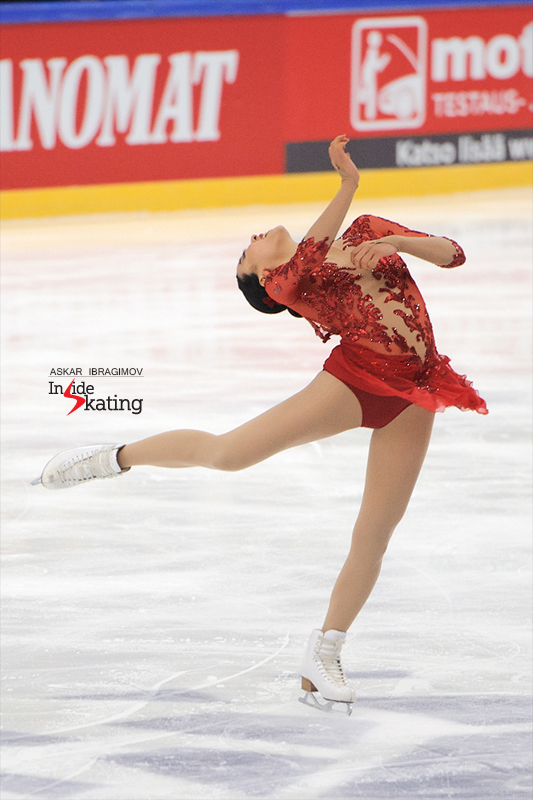For the first couple of seconds you only hear the cameras’ shutter buttons being pressed, and the piano. And see a feathery, black dress twirling and twizzling, and running away with your attention. Just like an Alphonse Mucha poster, or an Art Nouveau jewel, with shades, and nuances, and details, Mao Asada’s new short program screams masterpiece from top to finish. And it’s only equaled by her intricate free skate, both of them choreographed by Lori Nichol and performed to Manuel de Falla’s “Ritual Fire Dance”. A mysterious black bird in the first part, a fiery young lady in the second – with the ending pose of her SP being the opening of the free skate –, the two programs make for a bold, intriguing ice story, one that pushes the artistic boundaries of the sport and highlights to the maximum Mao Asada’s skills and sensibility.
by Florentina Tone
In a press conference in Espoo, right after the first outing of her short program in competition, Mao summarized the story in low voice and just a couple of words: “I have the same music in both my short and my long program; in the short, I’m like a black bird, a mysterious one, and for tomorrow I will change into a young lady”. That’s not the only difference though: the short program is set to the piano version of Manuel de Falla’s “Ritual Fire Dance”, with the piano played by virtuoso Artur Rubinstein, while the free uses the orchestral version of the same musical piece. Apparently Mao liked both pieces Lori Nichol suggested, and she just couldn’t decide between them. And out of Mao’s initial indecision, and her passion for both versions, we now have a larger story, in two parts, something that only Denis Ten had done in the recent past, when choosing to skate both his short and free to music from the movie “The Artist”; it happened during 2012-2013 season, with the same Lori Nichol as choreographer.
Danza ritual del fuego
We’ll have to agree with Mao Asada: Manuel de Falla’s “Danza ritual del fuego” is clearly addictive – and the most well-known movement of the ballet “El Amor Brujo” (literally, “Spelbound Love”), originally composed in 1915 and inspired by the flamenco music, and Pastora Imperio herself, an acclaimed flamenco dancer famous in the early 20th century. Pastora even had the lead role in the composition’s world premiere, on April 15, 1915, in Teatro Lara, in Madrid, dancing and singing – the original version of the piece, called “Gitanería”, included authentic Gitano folklore, and some other parts that were later removed. A day after its premiere, Madrid’s “La Tribuna” published a review alternating the good and the bad: for Tomás Borrás, this was “a music of strange sonorities; of rugged dissonances”, while to another person in the audience it was obvious that “the rich and hot blood of the Andalusian heart circulates, as in the veins of a beautiful body, throughout the score”. In the following years, Manuel de Falla revised the work more than once, arranging some of the main dances into orchestral suites and a suite for the piano, to unveil a final ballet version in Paris, in 1925; this particular arrangement of the piece is best known today.
“Ritual Fire Dance” is, if you wish, the quintessence of the entire ballet, whose plot is disarmingly simple: an Andalusian gypsy woman called Candelas finds new love, but she’s haunted by the ghost of her dead husband. To get rid of the ghost, sorcery is needed, so all the gypsies make a large circle around their campfire at midnight, while Candelas will perform a mysterious ritual dance; the ghost will follow the flames and the dance and, soon after, with all the women and their dresses whirling faster and faster, it will be drawn into the fire, vanishing for good. In her beautiful, red dress, with embroidery resembling the flames, Mao Asada is Candelas, the young Andalusian, in her long program this season, and her alluring, flirtatious dance is the way to recapture her freedom.
After skating her black, daring short program at her shows in Japan this summer, Mao Asada was ready to unveil the full story in Espoo, at this year’s edition of Finlandia Trophy; and that made her more nervous than usual on the day of the free skate, as she recalled later, in the press conference: “It was the first time I performed my long program, and it was not quite what I had hoped – I was more excited and nervous today than yesterday during my short program; the short program, I’d skated it before, in the shows. My next competition is Skate America – and I do want to make the corrections to those elements I didn’t succeed here, and to get better and better in the events preceding the World Championships”. A day before, she’d already stated she would add more difficult jumps in her short program – and she was clearly thinking, among other things, at her trademark triple Axel, that wasn’t in her repertory in Finlandia.
11 years after debuting on the senior circuit – and with one Olympic silver medal, five World medals, six Four Continents medals and 23 Grand Prix medals won in the process – Mao Asada is still aiming to improve, and that speaks hugely about herself and her spirit. Last year, she summarized it beautifully: she’s still here, on competitive ice, because she understood that “figure skating was essential to her”. We say Mao Asada is the one essential to skating. As are all of those wonderful skaters, like Carolina Kostner, like Tessa Virtue and Scott Moir, who have nothing else to prove when it comes to competitions and results, but who are still here, for the love of the sport. With the years, their skating gained maturity, and clarity, and sophistication, and a sense of understanding the music they didn’t have, at full potential, when they were teenagers. And their presence on the ice – a privilege to all of those watching figure skating – might very well be the biggest story of this pre-Olympic season.
Music flowing through her buttery arms
As for Mao Asada herself, she might have just hit the jackpot with this set of programs: a combination of restlessness and calm, long notes and rapid sequences of music, commanding everyone’s attention; with that final part of the short program, and the brilliant step sequence, creating huge anticipation for the free. And the truth is Mao’s expression has become so complex and so fluid over the years that almost every other skater out there looks like a beginner; with some notable exceptions, of course. Not a single movement is out of place, out of tune, nothing is forced, or interrupted, just the music flowing effortlessly through her buttery arms. And if I were to choose a moment of her redemptory free skate (which includes other musical fragments from “El Amor Brujo” too) – in my mind, I have already divided it in three: the tension, the quietness before the storm, the fiery dance – I’d choose the second part (“Pantomima”), with the soothing sound of the violins and the softness of her gliding. She’s an artist to the fingertips – in Mao’s case, that’s not just a figure of speech.
In terms of scores, Mao Asada was second at Finlandia Trophy, behind Canada’s Kaetlyn Osmond – and that was mainly due to her rather conservative jumping content in this event, but also to judges being equally conservative when it comes to her components. This is only the beginning of the season, of course, with both content and overall atmosphere of the programs enriching with time and competitions going by, but, even for this early stage, scores in the range of 6’s given by a particular judge for all set of Components – Skating Skills/Transitions/Performance/Composition/Interpretation of the Music – seem totally out of place. Even if not by much, Mao Asada’s PCS were still the highest of all competitors in both the short and the free, but they will clearly need to go up as the season progresses. Otherwise, it will look like only the longtime viewers of figure skating understand, appreciate and value Mao’s artistry, her control over the music and the programs.
And now let me ask you that: 10 years from now, what programs would you re-watch? I’ve already made (at least a part of) my list: Alexei Yagudin’s Winter. Maria Butyrskaya’s Scenes d’Amour. Oksana Grishuk & Evgeni Platov’s Memorial Requiem. Stéphane Lambiel’s Poeta. Marina Anissina & Gwendal Peizerat’s Flamenco. Daisuke Takahashi’s Pagliacci. Tessa Virtue & Scott Moir’s Carmen. Mao Asada’s Nocturne. Nathalie Péchalat & Fabian Bourzat’s The Little Prince and his rose. Carolina Kostner’s Ave Maria. Yuzuru Hanyu’s Ballade no. 1. Gabriella Papadakis & Guillaume Cizeron’s Concerto no. 23.
Mao Asada’s Ritual Fire Dance, in both versions, will be among those. It already is.
FURTHER READING
2015 Grand Prix Final: “Bellissima, bravissima Mao!”
Carolina Kostner: “I can search for my own best version, and then that’s my gift”

